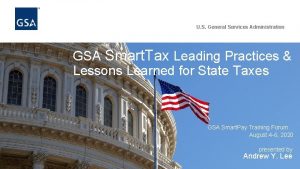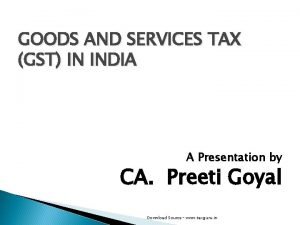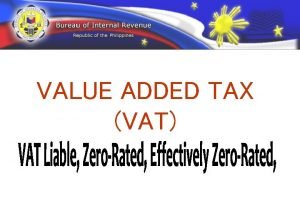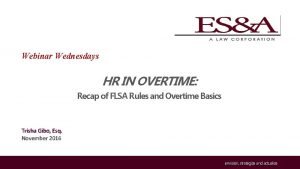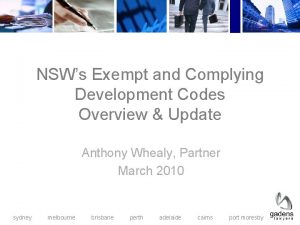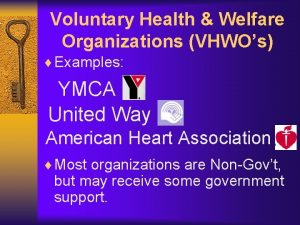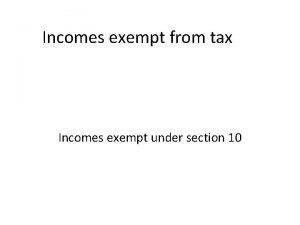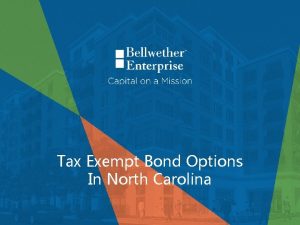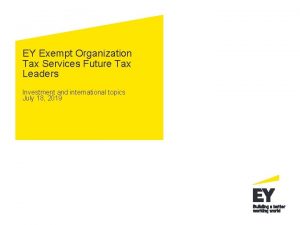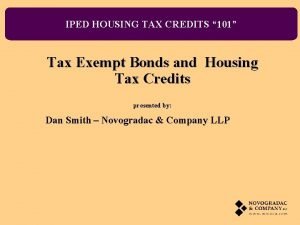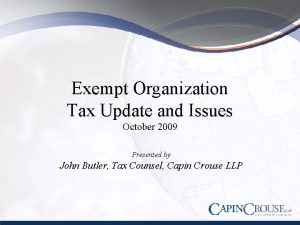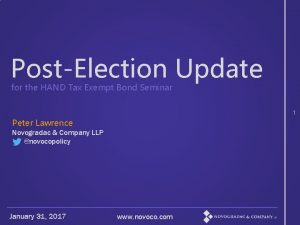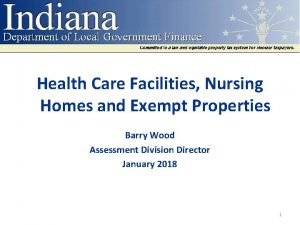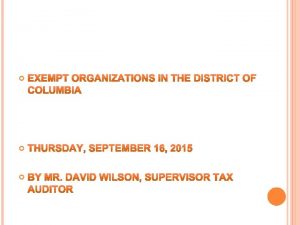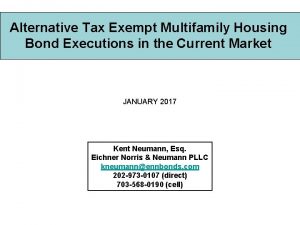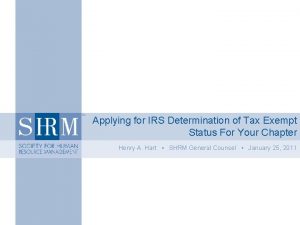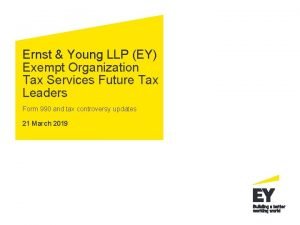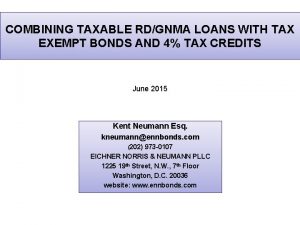Regulatory Update for Health Care Tax Exempt Organizations























- Slides: 23

Regulatory Update for Health Care Tax Exempt Organizations Tom Miller Manager, Exempt Organizations Technical

Three Hot Areas • Intermediate Sanctions – IRC § 4958 • Health Maintenance Organizations (HMO’s) • Joint Ventures

Intermediate Sanctions Conversions – Valuation Issues • Anclote Psychiatric Center v. Comm’r, T. C. Memo 1998 -273, aff’d 190 F. 3 d 5341 (12 th Cir. 1999). § Pre-IRC § 4958 transaction § Court upheld IRS revocation of exempt hospital that was sold to insiders for less than FMV § Sale price: $6. 6 million. § Two years later, resold for $29. 6 million

Intermediate Sanctions The Basics of IRC § 4958 • 25 % Initial Tax § On Excess Benefit § Provided by Applicable Tax Exempt Organization § To a Disqualified Person • 200% Second-level tax § If EBT not Corrected • 10% Tax on Knowing Manager § Unless participation not willful and due to reasonable cause

Intermediate Sanctions Basics of IRC § 4958 • Applicable Tax-Exempt Organizations § § 501(c)(3) Public Charities § § 501(c)(4) Social Welfare Organizations (e. g. , HMO’s) • Disqualified Person is a “Person Who is in a Position to Exert Substantial Influence Over the Organization

Intermediate Sanctions Basics of IRC § 4958 • “Excess Benefit Transaction” includes § Compensation § Sale, Exchange, or Use of Assets § Loan • In Which Organization Receives Less than the Value in Return

Intermediate Sanctions Conversions – Valuation Issues • Caracci, et. ux. , et. al. v. Comm’r, 118 T. C. No. 25 (May 22, 2002) (Sta-Home Health) § First IRC § 4958 litigation § Several home health agencies transferred to disqualified persons for less than FMV § Valuation an issue. TP’s argued negative FMV § Court found total value > $5 million § Court upheld § 4958, overturned IRS revocation

Intermediate Sanctions Compensation Issues • § 4958 Issues Will be Considered in EO Examinations § Factual issues • Planning is Key to Avoiding Difficulty § Establish Rebuttable Presumption of Reasonableness – Treas. Regs. § 53. 4958 -6 § Document Intent that Fringe Benefits (other than § 132 benefits) are Compensation

Intermediate Sanctions Rebuttable Presumption • Three requirements – Regs. § 53. 4958 -6(c) § Advance approval by Authorized Body • E. g. , Board of Dir. , Executive Committee • No one with conflict of interest § Reliance on Comparable Data § Concurrent Documentation • • • Terms and date approved Members of body present for debate and who voted Comparability data relied on and how obtained Reasons for any variance from comparability data Actions by any member with a conflict

Intermediate Sanctions Fringe Benefits • Economic Benefits that are treated as compensation are considered with all other compensation to determine reasonableness. § Exclude certain kinds, e. g. , § 132 exclusions • Economic Benefit that is not treated as compensation is EBT, unless DP can show § Properly excluded from income, or § Involved legitimate non-comp transaction with organization

Intermediate Sanctions Showing Intent that Fringe Benefits are Compensation • Intent shown by Contemporaneous Substantiation § Organization reports on original or amended Form W-2, 1099, or 990, filed before audit § DP reports benefit as income on original or amended Form 1040, filed before audit § Contemporaneous documentation of approval by authorized body or officer • Rebuttable Presumption documentation • Approved written employment contract

Intermediate Sanctions (IRC 4958) Update • FY 2003 CPE article • www. irs. gov/pub/irs-tege/eotopice 03. pdf

HMO’s Exemption Issues: § 501(c)(3) or § 501(c)(4) • § 501(c)(3) § If providing members direct hospital and medical services, i. e. , like a hospital § Sound Health Ass’n v. Comm’r, 71 T. C. 158 (1978), acq. 1981 -2 C. B. 2. § Standard to qualify is “promotion of health that benefits the community. ” Rev. Proc. 69 -545, 1969 -2 C. B. 117 (e. g. , factors such as emergency room, Medicare/Medicaid, community board, training)

HMO’s Exemption Issues: § 501(c)(3) or § 501(c)(4) • Not § 501(c)(3) § Will not qualify if HMO an arranger, even if established by § 501(c)(3) hospital • Geissinger Health Plan v. Comm’r, 985 F. 2 d 1210 (3 rd Cir. 1993); • IHC Health Plans Inc. et. al. v. Comm’r, T. C. Memo 2001 -246, 247, 148. (On appeal to 10 th Cir. ) § Courts held • Not operated exclusively for charitable purposes by promoting health of the community • Did not qualify based on relationship to tax-exempt hospital

HMO’s Exemption Issues: § 501(c)(3) or § 501(c)(4) • § 501(c)(4) § HMO may qualify as a social welfare organization if accessible by an underserved segment of the community. § e. g. , elderly, individuals, small employers, etc.

HMO’s Exemption Issues: § 501(m) Bar • If providing commercial-type insurance is substantial part of activities § 501(m) denies exemption under (c)(3) or (4) • Directed at BC/BS organizations • No definition of “commercial-type insurance”

HMO’s Exemption Issues: § 501(m) Bar • Several court cases have interpreted it as “same type that commercial carriers offer. ” § Cases did not involve HMO § Paratransit Insurance Corporation v. Comm’r, 102 T. C. 745 (1994) § Florida Hospital Trust Fund v. Comm’r, 103 T. C. 140 (1994), aff’d on other grounds 71 F. 3 rd 808 (11 th Cir. 1996) § Nonprofits’ Insurance Alliance of California, 32 Fed Cl. 277 (1994)

HMO’s § 501(m) • Rush Prudential HMO, Inc. v. Moran, 536 U. S. 355 (2002), held an HMO was providing insurance. § Not a tax case § Upheld a State HMO Statute § Held ERISA did not preempt state statute because HMO provided insurance • We are reviewing whether rationale of Rush affects how § 501(m) applies to HMO’s.

Joint Ventures Rev. Rul. 98 -15, 1998 C. B. 718 • Two examples where hospital puts all assets in partnership with for-profit partners • Situation 1 meets § 501(c)(3) because § JV governing documents commit to benefit community as whole; § Charitable purposes trump profits; § Exempt partner controls partnership; § Management contract reasonable. • Situation 2 did not meet § 501(c)(3) § No binding obligation to serve charitable purposes; § Shared control limits ability to require charity

Joint Ventures Examples • Redlands Surgical Services v. Comm’r, 113 T. C. 47 (1999), aff’d per curiam, 242 F 3 rd 904 (9 th Cir. 2001). § Subsidiary of tax-exempt hospital entered JV with forprofit to operate outpatient surgery center. § Court upheld denial of § 501(c)(3) status • NP partner lacked control; • Did not show benefited community – no Medicare/Medicaid, or charity care

Joint Ventures Examples • St. David’s Health Care System v. U. S. , No. 01 CV 46 (W. D. Tex. June 7, 2002) § § 501(c)(3) hospital in 50/50 Partnership with for-profit § District Court, on summary judgment, held consistent with exempt status § Court found tax-exempt’s lack of authority to require charity did not affect status if actual operations OK § On appeal to Fifth Circuit

Joint Ventures • IRS/Treasury Committed to Additional Guidance on Joint Ventures • Situations may be Ancillary JV § § 512(c) provides partnership income retains its character, so EO partner’s share of partnership’s income from unrelated activity is UBI

Customer Service Toll Free Exempt Organizations Assistance 1 -877 -829 -5500 IRS Exempt Organizations Website www. irs. gov/eo IRS Forms and Publications Website www. irs. gov/formspubs
 Are local governments tax exempt
Are local governments tax exempt Are city governments tax exempt
Are city governments tax exempt Gsa tax exempt map
Gsa tax exempt map E595 form nc
E595 form nc Shadow paging recovery technique
Shadow paging recovery technique Gst conclusion
Gst conclusion Ralphs annual income is about $32 000
Ralphs annual income is about $32 000 Types of care primary secondary tertiary
Types of care primary secondary tertiary Persons exempt from vat
Persons exempt from vat Exempt employee definition
Exempt employee definition Non assessable income examples
Non assessable income examples Exempt development code
Exempt development code Care value base health and social care
Care value base health and social care Voluntary health and welfare organizations
Voluntary health and welfare organizations Health and social care component 3
Health and social care component 3 Kontinuitetshantering i praktiken
Kontinuitetshantering i praktiken Typiska drag för en novell
Typiska drag för en novell Tack för att ni lyssnade bild
Tack för att ni lyssnade bild Returpilarna
Returpilarna Varför kallas perioden 1918-1939 för mellankrigstiden
Varför kallas perioden 1918-1939 för mellankrigstiden En lathund för arbete med kontinuitetshantering
En lathund för arbete med kontinuitetshantering Särskild löneskatt för pensionskostnader
Särskild löneskatt för pensionskostnader Tidböcker
Tidböcker Anatomi organ reproduksi
Anatomi organ reproduksi


